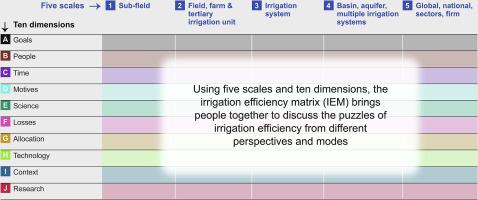Global Environmental Change ( IF 8.6 ) Pub Date : 2020-10-20 , DOI: 10.1016/j.gloenvcha.2020.102182 Bruce Lankford , Alvar Closas , James Dalton , Elena López Gunn , Tim Hess , Jerry W Knox , Saskia van der Kooij , Jonathan Lautze , David Molden , Stuart Orr , Jamie Pittock , Brian Richter , Philip J Riddell , Christopher A Scott , Jean-philippe Venot , Jeroen Vos , Margreet Zwarteveen

|
An effective placement of irrigation efficiency in water management will contribute towards meeting the pre-eminent global water challenges of our time such as addressing water scarcity, boosting crop water productivity and reconciling competing water needs between sectors. However, although irrigation efficiency may appear to be a simple measure of performance and imply dramatic positive benefits, it is not straightforward to understand, measure or apply. For example, hydrological understanding that irrigation losses recycle back to surface and groundwater in river basins attempts to account for scale, but this generalisation cannot be readily translated from one location to another or be considered neutral for farmers sharing local irrigation networks. Because irrigation efficiency (IE) motives, measures, effects and technologies play out at different scales for different people, organisations and purposes, and losses differ from place to place and over time, IE is a contested term, highly changeable and subjective. This makes generalisations for science, management and policy difficult. Accordingly, we propose new definitions for IE and irrigation hydrology and introduce a framework, termed an ‘irrigation efficiency matrix’, comprising five spatial scales and ten dimensions to understand and critique the promises, pitfalls and paradoxes of IE and to unlock its utility for addressing contemporary water challenges.
中文翻译:

基于规模的框架,以了解灌溉效率的承诺,陷阱和悖论,以应对主要的水挑战
有效地将灌溉效率置于水资源管理中,将有助于应对当今时代最重要的全球水资源挑战,例如解决水资源短缺,提高农作物水分生产率以及协调部门之间相互竞争的水需求。然而,尽管灌溉效率似乎只是衡量绩效的简单指标,并暗示了巨大的积极效益,但要理解,衡量或应用这一指标并非易事。例如,水文认识到灌溉损失在流域循环回地表水和地下水,这试图解释规模,但是这种概括不能轻易地从一个地点转换到另一个地点,或者对于共享本地灌溉网络的农民来说,这种概算是中立的。因为灌溉效率(IE)的动机,措施,效果和技术针对不同的人员,组织和目的以不同的规模发挥作用,并且损失因地而异,并且随着时间的流逝,IE是一个有争议的术语,易变且主观。这使得很难对科学,管理和政策进行概括。因此,我们为IE和灌溉水文学提出了新的定义,并引入了一个被称为“灌溉效率矩阵”的框架,该框架包括五个空间尺度和十个维度,以理解和批评IE的前景,陷阱和悖论,并释放其在解决IE方面的效用。当代水挑战。管理和政策困难。因此,我们为IE和灌溉水文学提出了新的定义,并引入了一个被称为“灌溉效率矩阵”的框架,该框架包括五个空间尺度和十个维度,以理解和批评IE的前景,陷阱和悖论,并释放其在解决IE方面的效用。当代水挑战。管理和政策困难。因此,我们为IE和灌溉水文学提出了新的定义,并引入了一个被称为“灌溉效率矩阵”的框架,该框架包括五个空间尺度和十个维度,以理解和批评IE的前景,陷阱和悖论,并释放其在解决IE方面的效用。当代水挑战。











































 京公网安备 11010802027423号
京公网安备 11010802027423号